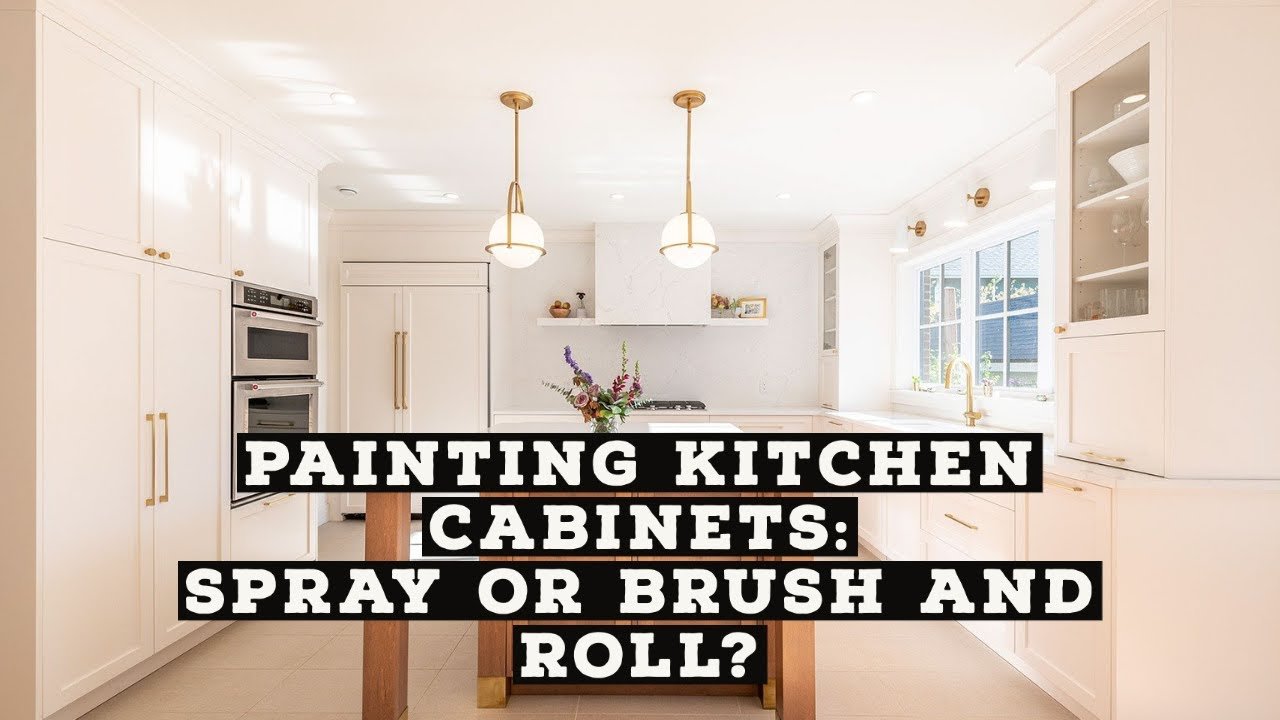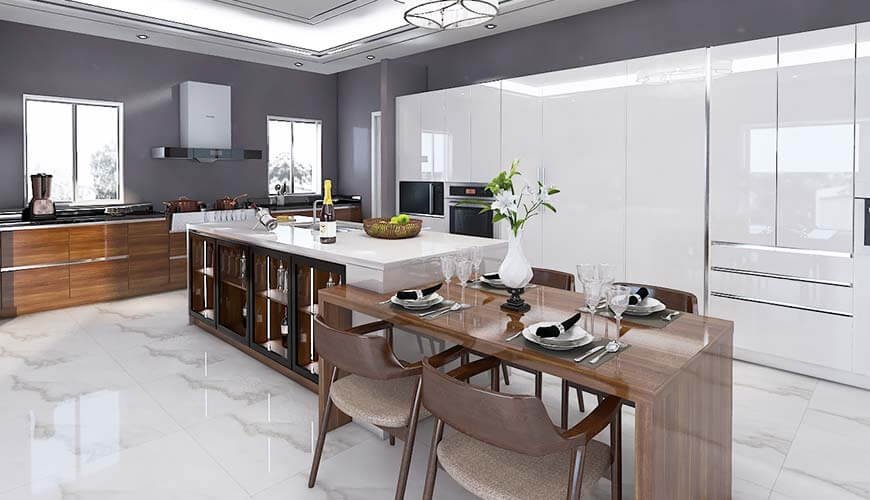Spraying kitchen cabinets provides a smoother finish, while rolling offers more control and is less messy. Your choice depends on your desired finish and skill level.
Choosing between spraying and rolling kitchen cabinets can impact the final look and durability of your project. Spraying delivers a sleek, professional finish with even coverage but requires more preparation and equipment. Rolling is simpler, more accessible for DIY enthusiasts, and offers greater control, reducing the risk of overspray.
Both methods have pros and cons, such as time efficiency, ease of use, and the quality of finish. Understanding these differences helps you make an informed decision that suits your skills, budget, and the outcome you envision for your kitchen cabinets.
Table of Contents
ToggleSpraying Cabinets
Choosing the right method for painting kitchen cabinets is crucial. Spraying cabinets can offer a sleek, professional finish. But is it the right method for you? Let’s delve into the pros and cons of spraying cabinets.
Pros Of Spraying
Spraying cabinets offers a smooth and even finish. This method can cover large areas quickly. Here are some key benefits:
- Quick Application: Spraying covers large surfaces fast.
- Even Coating: Achieves a smooth and uniform finish.
- Less Brush Marks: Reduces visible brush strokes.
Using a spray gun can also reach tight corners and edges. This ensures a consistent look across all cabinet surfaces.
Cons Of Spraying
While spraying has many advantages, there are some drawbacks:
- Requires Equipment: Need a spray gun and compressor.
- Preparation Time: Must mask and cover surrounding areas.
- Ventilation Needed: Spraying produces more overspray and fumes.
Spraying can also be messy. Proper cleanup is essential to avoid damage to other surfaces.
Additionally, beginners may find spray techniques difficult to master.
:strip_icc()/505HickmanSt.0268_preview-8215f3894c074907ae387258a405c533.jpg)
Rolling Cabinets
Rolling cabinets is a common method for applying paint. It involves using a paint roller. Many homeowners prefer this method for its simplicity. But is it the best choice for your kitchen cabinets? Let’s explore the pros and cons.
Pros Of Rolling
- Easy to Use: Rolling is simple. Even beginners can do it.
- Low Cost: Rollers are affordable. You don’t need expensive equipment.
- Less Mess: Rolling creates less overspray. Your kitchen stays cleaner.
- Great for Large Areas: Rollers cover large surfaces quickly.
Cons Of Rolling
- Not as Smooth: Rolling can leave texture. It’s not as smooth as spraying.
- Hard to Reach Areas: Rollers struggle with corners and edges.
- Time-Consuming: Rolling can take longer. Details need more attention.
| Pros | Cons |
|---|---|
| Easy to Use | Not as Smooth |
| Low Cost | Hard to Reach Areas |
| Less Mess | Time-Consuming |
| Great for Large Areas |
Tools And Materials
Choosing between spraying or rolling your kitchen cabinets requires the right tools and materials. Knowing what you need can make the job easier and ensure a professional finish.
Essential Spraying Tools
Spraying kitchen cabinets gives a smooth, even finish. Here are the tools you’ll need:
- Paint Sprayer: An HVLP (High Volume Low Pressure) sprayer works best.
- Compressor: Ensures consistent pressure for a smooth spray.
- Paint Strainer: Filters out any lumps in the paint.
- Drop Cloths: Protects floors and surfaces from overspray.
- Masking Tape: Covers areas you don’t want to paint.
- Protective Gear: Includes masks, goggles, and gloves for safety.
Essential Rolling Tools
Rolling is a simpler method and requires fewer tools. Here’s what you need:
- High-Quality Paint Roller: A foam roller provides a smooth finish.
- Paint Tray: Holds the paint for easy rolling.
- Angled Brush: Perfect for corners and edges.
- Sandpaper: Smooths out surfaces before painting.
- Tack Cloth: Removes dust and debris from surfaces.
- Painter’s Tape: Protects areas you do not want to paint.

Preparation Steps
Before deciding whether to spray or roll your kitchen cabinets, proper preparation is crucial. This ensures the best results and longevity of the finish. Follow these essential preparation steps to achieve a flawless look.
Cleaning And Sanding
Start by thoroughly cleaning your cabinets. Use a degreaser to remove grime and grease. Wipe down all surfaces with a damp cloth and let them dry.
Next, sanding is vital for a smooth finish. Use 120-grit sandpaper to sand all surfaces. This helps the primer and paint adhere better. Wipe off dust with a tack cloth after sanding.
Protecting Surrounding Areas
Protecting your kitchen from paint splatters is essential. Use painter’s tape to cover edges and corners. Lay down drop cloths to protect floors and countertops.
Consider covering appliances with plastic sheeting. This prevents accidental paint drips. Ensuring these areas are protected saves time on clean-up later.
Proper preparation is the key to a successful painting project. Follow these steps for a professional finish.
| Step | Action |
|---|---|
| Cleaning | Use a degreaser, wipe with a damp cloth. |
| Sanding | Sand with 120-grit, wipe with tack cloth. |
| Protecting | Use painter’s tape, drop cloths, plastic sheeting. |
Application Techniques
Choosing between spraying or rolling kitchen cabinets can be a tough decision. Each method has its unique benefits. Understanding the application techniques can help you make an informed choice. Below, we discuss the best practices for both spraying and rolling your kitchen cabinets.
Best Practices For Spraying
Spraying kitchen cabinets can deliver a smooth and professional finish. Follow these best practices for optimal results:
- Preparation: Clean and sand the surfaces thoroughly. Remove all grease and dirt.
- Primer: Apply a high-quality primer to ensure better paint adhesion.
- Setup: Use a spray gun in a well-ventilated area. Cover all areas you do not want to spray.
- Technique: Hold the spray gun 10-12 inches away from the surface. Move in steady, even strokes.
- Multiple Coats: Apply multiple thin coats instead of one thick coat. This ensures even coverage.
- Drying Time: Allow adequate drying time between coats. This prevents drips and uneven texture.
Best Practices For Rolling
Rolling kitchen cabinets is a straightforward and budget-friendly option. Follow these best practices for the best outcome:
- Preparation: Clean and sand the surfaces. This step is crucial for paint adhesion.
- Primer: Apply a suitable primer. This provides a good base for your paint.
- Roller Type: Use a high-density foam roller. This type minimizes texture marks.
- Technique: Roll in one direction. Use light pressure to avoid roller marks.
- Multiple Coats: Apply several thin coats. This ensures a smooth and even finish.
- Drying Time: Allow each coat to dry completely. This prevents smudging and peeling.
Finishing Touches
The final steps in your kitchen cabinet project are crucial. They ensure a professional look and long-lasting finish. Whether you spray or roll, these finishing touches make a difference.
Drying And Curing
Drying and curing are essential parts of the process. Paint needs enough time to dry and harden. This prevents smudges and dents.
For sprayed cabinets, the drying time is usually shorter. This is due to the thin, even layers of paint. Rolled cabinets might take longer to dry. This is because the paint is usually applied thicker.
Here is a quick comparison:
| Method | Drying Time | Curing Time |
|---|---|---|
| Spraying | 1-2 hours | 1-2 weeks |
| Rolling | 2-4 hours | 2-3 weeks |
Inspecting The Final Result
Inspect the final result carefully. Look for any imperfections or missed spots. Use good lighting to see all areas clearly.
Here’s a checklist to help you:
- Check for even coverage.
- Look for drips or runs in the paint.
- Ensure all edges are smooth.
- Verify the paint is fully dry and cured.
If you find any issues, touch them up quickly. This ensures a flawless finish.
Expert Recommendations
Refinishing kitchen cabinets can dramatically enhance your kitchen’s look. Experts often debate whether to spray or roll paint on cabinets. Each method has its advantages. This guide provides expert recommendations on when to spray and when to roll.
When To Spray
Spraying paint on kitchen cabinets offers a smooth finish. Professionals recommend spraying if you have large, flat surfaces. This method is best for achieving a factory-like finish. Spray painting is also faster for covering large areas.
- Speed: Spraying covers large areas quickly.
- Finish: Provides a smooth, even look.
- Detail: Ideal for intricate designs.
Spraying works well if you have proper ventilation. Use a paint sprayer for a seamless, professional look.
When To Roll
Rolling paint is ideal for smaller kitchens. It offers more control over the application. Experts suggest rolling for detailed work and small areas. Rolling paint is also less messy and easier for beginners.
- Control: Better for small, detailed sections.
- Mess: Less paint overspray and mess.
- Ease of Use: Easier for DIY projects.
Rolling is perfect for those who want precision. Use high-quality rollers for the best results.
| Method | Best For | Advantages |
|---|---|---|
| Spraying | Large surfaces | Smooth finish, fast application |
| Rolling | Small areas | More control, less mess |

Frequently Asked Questions
Is Spraying Better Than Rolling Cabinets?
Spraying offers a smoother, more professional finish compared to rolling.
What Are The Benefits Of Spraying Cabinets?
Spraying provides even coverage and a flawless look, reducing brush marks.
How Long Does Spraying Cabinets Take?
Spraying typically takes less time due to faster application and drying.
Can I Spray Cabinets Myself?
Yes, with the right equipment and preparation, you can spray cabinets yourself.
What Equipment Is Needed For Spraying Cabinets?
You’ll need a paint sprayer, masking tape, drop cloths, and safety gear.
Is Rolling Cabinets More Affordable?
Rolling can be more budget-friendly since it doesn’t require specialized equipment.
Does Rolling Cabinets Leave Brush Marks?
Yes, rolling can leave brush marks and an uneven finish.
Which Method Lasts Longer?
Spraying often provides a more durable and long-lasting finish.
Can I Mix Spraying And Rolling?
Yes, you can spray large areas and roll smaller, detailed parts.
What Type Of Paint Is Best For Cabinets?
Use high-quality, durable paint specifically designed for cabinets.
Conclusion
Choosing between spraying or rolling your kitchen cabinets depends on your needs and skills. Spraying offers a smooth finish, while rolling provides more control. Consider your budget, time, and desired outcome. Make an informed decision to achieve the best results for your kitchen renovation.
Happy painting!


